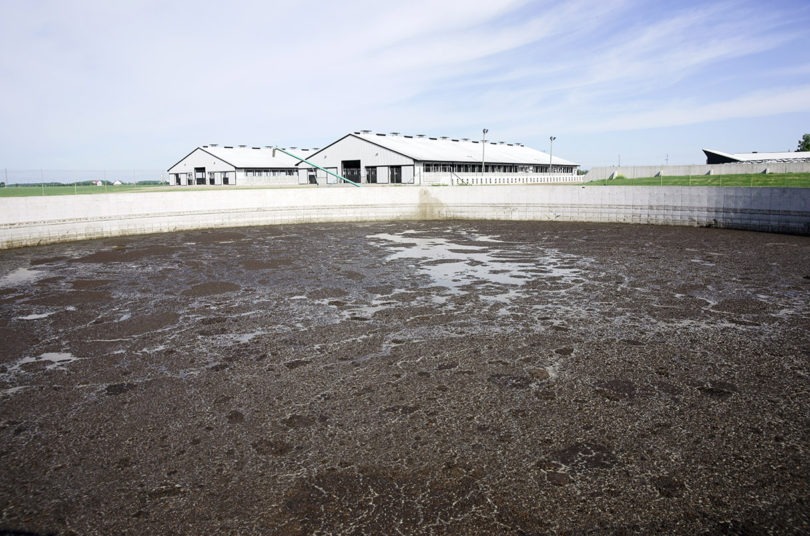Let’s discuss an unfavorable issue. Each year, global livestock farms produce over 3 billion tons of animal waste, which is equivalent to more than 9000 Empire State Buildings. This massive amount of manure pollutes water bodies, emits harmful fumes, and contributes to greenhouse gas emissions. However, there is a new recycling technique that could alleviate these issues and even generate profits.
Researchers have discovered that by utilizing electricity, they can break down organic nutrients in animal waste while also recovering valuable chemicals. According to preliminary projections published in Nature Sustainability, the value of these chemicals would generally exceed the technique’s costs, making it a profitable option for farmers.
This approach shows promise, particularly in rural, agricultural areas that have an abundance of both manure and affordable renewable electricity from wind and solar farms, as explained by Taeyoung Kim, a chemist at Clarkson University who was not involved in the study.
Currently, many livestock operations attempt to recycle animal waste by depositing it into manure lagoons. The solids rich in ammonia that settle at the bottom can be collected and spread as fertilizer on farmland. Microbes are then used to break down the remaining organic compounds into methane, which can be harnessed to generate electricity. However, even with these treatments, substantial amounts of ammonia and other compounds still end up being released into the environment, leading to algal blooms and fish fatalities.
Recent studies have explored electrochemical methods to capture valuable chemicals like ammonia from manure lagoons. For example, in a lab study conducted in 2021, Kim and his colleagues developed a battery-like system that utilized an electric current to drive ammonium ions through a membrane, making it easier to recover the fertilizer precursor. However, membrane setups can be complicated to handle and costly to scale up.
To overcome these challenges, researchers led by University of Wisconsin-Madison environmental engineer Mohan Qin and chemistry colleague Song Jin devised a two-stage approach that eliminates the need for a membrane. Both stages rely on a battery electrode material called potassium nickel hexacyanoferrate (KNiHCF), which has a layered structure with gaps allowing ions to move freely.
In the first step, a KNiHCF electrode is immersed in a synthetic animal wastewater solution. The KNiHCF electrode, being electron-hungry, naturally extracts electrons from organic compounds in the wastewater, causing them to break down. As negative charges accumulate in the KNiHCF, positive ions from the solution are drawn in and inserted between its layers. The researchers observed that the spacing of the layers in KNiHCF is ideal for attracting valuable ions like ammonium and potassium, rather than less valuable ions found in manure such as sodium or calcium. Kim considers this a significant advantage of the setup.
The second step involves removing the KNiHCF electrode, which is now saturated with ions, from the wastewater solution. It is then placed, along with another electrode, in a separate container filled with clean water containing an ion-conducting electrolyte. Applying a voltage causes electrons to flow into the second electrode, creating a negative charge that pulls the positively charged ammonium and potassium ions out of the KNiHCF electrode and into the solution. This allows for concentration and easy recovery of these ions. Additionally, the setup has an added benefit: negative charges in the second electrode trigger a reaction between water, oxygen, and valuable chemicals like hydrogen gas or hydrogen peroxide, which can be sold along with the recovered ammonia and potassium.
Although the approach has some limitations, such as the degradation of KNiHCF electrodes with repeated use, the researchers are already addressing this challenge. They also conducted an analysis to evaluate the setup’s potential for scaling up and managing waste from a dairy farm with 1000 cows. The results showed that the operation could generate enough valuable chemicals to yield an annual profit of up to $200,000, considering an electricity price of around $0.08 per kilowatt hour (kWh), which is the U.S. average.
Jin points out that the cost of electricity in rural areas is expected to decline to approximately $0.03 per kWh by 2030, thanks to renewable energy sources. Wind and solar farms often produce excess electricity, causing engineers to either discard it or shut down their turbines. Jin suggests that by combining this electrochemical technique with renewable energy sources, it could be designed to operate when electricity prices are low.
The economic analysis did not take into account the environmental benefits of reducing downstream nutrient pollution, as highlighted by Qin. Considering the overall efficiency of the process, she believes that the electrochemical treatment could capture almost 70% of the ammonia in manure and reduce farm emissions of this compound by a similar amount. It is indeed a compact and efficient solution to address an age-old problem.

